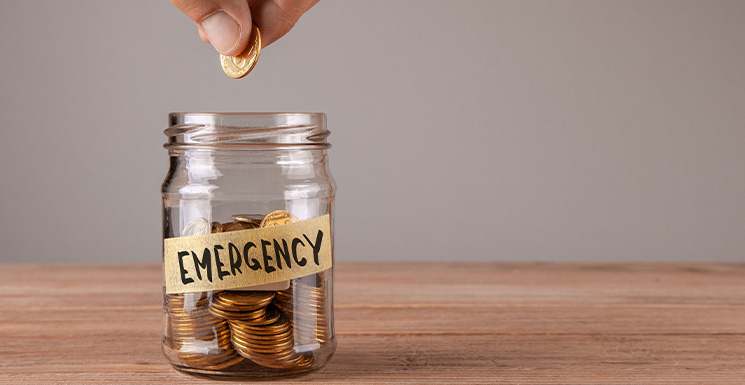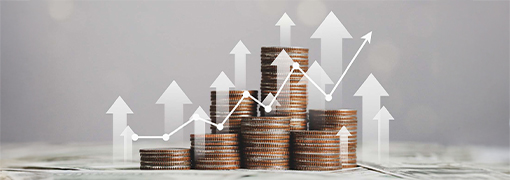What Is an Emergency Fund?

Unexpected expenses have a way of showing up when you least expect them. A sudden car repair, medical bill, or job loss can throw your budget into chaos if you are not prepared. Without savings, even a minor setback can turn into long-term debt.
An emergency fund is a financial safety net designed to protect you from life’s surprises. With the right savings in place, you can cover urgent expenses without relying on credit cards or loans.
Table of ContentsExplore Saving Account Options
An emergency fund is money set aside for unexpected expenses.
Financial experts recommend saving three to six months of living costs.
The best place for your funds is a safe, liquid account, such as a savings account.
Building an emergency fund requires consistent effort but pays off during times of financial stress.
Knowing what qualifies as an emergency is key to protecting your savings.
Why an Emergency Fund Matters?
How Much Should You Save in an Emergency Fund?
Where to Keep Your Emergency Fund?
How to Build Your Emergency Fund?
Most people face financial surprises at some point. The problem is not the expense itself but being unprepared for it.
A dedicated emergency fund keeps those surprises from turning into financial setbacks.
Unexpected costs happen in nearly every household. These are some of the most common:
Job loss or reduced hours
Medical expenses not fully covered by insurance
Car repairs that affect your ability to work or commute
Home repairs, such as a furnace breakdown or a roof leak
Travel costs for urgent family matters
The benefits of having a strong emergency fund go beyond paying bills. Key advantages include:
Avoids debt: You do not need to use credit cards or loans.
Provides stability: You can cover essential expenses during income loss.
Protects financial goals: You avoid withdrawing from retirement or long-term savings.
Reduces stress: A sense of peace of mind comes from knowing you are prepared.
There’s no one-size-fits-all number. Most financial advisors recommend saving three to six months of living expenses. This provides a strong foundation to remain stable during challenging times.
If that goal feels out of reach right now, start with $1,000. Once you reach that milestone, aim for three months' worth of expenses. From there, work toward a six-month goal.
Breaking your savings into clear, achievable benchmarks makes it easier to stay motivated and build long-term financial security.
The right savings target depends on your situation. Consider these factors:
Understanding these factors can help you make smarter financial decisions to build and maintain a strong credit score.
Take the next step toward financial stability. Fill out our Financial Fitness Assessment and get personalized guidance from a local banker.
Your emergency fund should be safe, accessible, and low-risk. You want quick access when life throws you a curveball. The goal is to protect your money, not aggressively grow it.
These account types offer security, flexibility, and peace of mind:
High-yield savings account: Earn interest while keeping your money available. Ideal for fast access and low risk.
Money market account: Combines savings with limited check-writing or debit access. Great for larger balances and added flexibility.
Certificates of deposit (CDs): Use for a portion of your fund that you don’t need immediately. CDs offer higher returns but charge penalties for early withdrawals.
Some accounts aren’t built for emergencies. Avoid these options:
Stocks or bonds: Market volatility makes them unreliable for urgent needs. You could lose value when you need cash most.
Retirement accounts: Early withdrawals trigger penalties and taxes. These accounts are for long-term goals, not short-term emergencies.
Physical cash only: Cash doesn’t earn interest and isn’t secure. If it’s lost or stolen, it’s gone. Keep a small amount on hand but store the rest in a trusted account.
Looking to grow your emergency fund faster? Start local. FSB offers savings accounts and short-term CDs designed to help Eastern Iowans build savings with confidence.
Whether you're in Marion, Cedar Rapids, or Iowa City, our bankers are here to help you choose the right account and set smart savings goals!
Even if your savings account is empty today, you can start building. Building an emergency fund is easier when you take it one step at a time.
Start with $500 to $1,000. This gives you a buffer for small emergencies like car repairs or medical bills.
Once you reach that, aim for three months of living expenses. From there, work toward a six-month savings goal.
If you're in Eastern Iowa and unsure where to start, FSB’s Financial Fitness Assessment can help you set a personalized savings target.
To build your emergency fund, it's essential to understand your monthly expenses. Start by listing your essential expenses:
Housing
Utilities
Food
Transportation
Insurance
These are the costs your savings should cover. Skip non-essentials like entertainment, streaming services, or impulse purchases. Your goal is to calculate your core living expenses so you know how much to save for three to six months of coverage.
Building an emergency fund takes consistency. There is no specific way to do this; it's whatever works for you. The easiest way to stay on track is to create a savings strategy that fits your lifestyle and income.
Treat your emergency fund like a monthly bill. Set up automatic scheduled transfers from your checking account to your savings account each payday. Even small amounts, such as $25, $50, or $100, add up over time.
FSB’s online banking tools make it easy to schedule transfers and track your progress.
To hit your savings goal, you need to know how much to “pay” into your emergency fund each month. Start with your total savings target, such as three months of living expenses, and divide it by the number of months you want to reach it in.
This gives you a clear monthly amount to “pay” into your emergency fund.
Windfall income is any unexpected or extra income. This could be a bonus, tax refund, raise, inheritance, or even a cash gift. Instead of spending it all, use part of it to grow your emergency fund.
Windfalls are a great way to make fast progress. A single deposit of $500 or $1,000 can move you closer to your savings goal without impacting your regular budget. If you receive a windfall, decide in advance how much you’ll save, then transfer it right away.
Cash-back rewards are an easy way to grow your emergency fund without changing your budget. If you earn rewards from credit cards, loyalty programs, or FSB's High 5 Rewards Checking Account, treat that money like a savings boost.
Freeing up money helps you build your emergency fund faster. Begin by reviewing your monthly spending and identifying areas where you can reduce it.
Focus on cutting:
Unused subscriptions: Cancel streaming services, apps, or memberships you don’t use.
Eating out: Cook at home and plan meals to avoid impulse spending.
Grocery overspending: Shop with a list, use store rewards, and avoid buying without a plan.
Impulse purchases: Wait 24 hours before making non-essential purchases. Most of the time, you won’t miss them.
Overpriced services: Compare rates for phone, internet, and insurance. You might find better deals.
Use the extra cash to boost your savings. Every dollar you save moves you closer to your emergency fund goal.
Extra income gives your emergency fund a jumpstart. Even small side earnings can make a big impact.
See if any of these strategies may apply to you:
Freelance or part-time work: Eastern Iowa businesses often offer flexible roles in retail, hospitality, or remote support.
Sell unused items: Furniture, electronics, and clothing can bring in quick cash through local marketplaces or online platforms.
Save bonuses, raises, or tax refunds: These windfalls are perfect for one-time deposits into your emergency fund.
Seasonal work or weekend gigs: Farmers markets, festivals, and local events in Cedar Rapids, Marion, or Iowa City often need short-term help.
Use your skills: Offer tutoring, yard work, pet sitting, photography, or handyman services. Local demand is strong, and your time is valuable.
Every extra dollar helps you reach your savings goal faster. Combine these strategies with scheduled transfers to stay consistent.
Your emergency fund is for unexpected, essential expenses that may arise. It’s not meant for everyday spending or planned purchases. Use it only when you truly need it.
True emergencies usually fall into these categories:
Major car repairs needed to maintain transportation
Sudden medical bills not covered by insurance
Job loss or reduced hours that impact your income
Home repairs that affect safety or basic living conditions
Urgent travel for family emergencies
These situations are unpredictable and can disrupt your financial stability. That’s when your emergency fund steps in.
It’s important to protect your savings by using them only when necessary. Avoid dipping into your fund for:
Vacations or holiday spending
Planned purchases like furniture, electronics, or appliances
Non-essential home upgrades, like remodeling projects
Non-essential activities like entertainment or shopping
If you’re unsure whether something qualifies, ask yourself: Is this unexpected, urgent, and necessary? If not, it’s best to leave your emergency fund untouched.
For the types of purchases listed above, it’s smart to set up a separate savings account. This account can help you plan for vacations, home improvements, or major purchases like furniture and electronics.
Keeping these funds separate from your emergency savings protects your financial safety net and keeps your goals organized.
Not all savings accounts serve the same purpose. Knowing the difference helps you manage your money with confidence.
A rainy day fund covers small, irregular expenses. These include things like minor car repairs, veterinary bills, or unexpected gifts. They’re inconvenient but manageable.
An emergency fund is for major disruptions. Use it when your income or safety is at risk. That includes job loss, medical emergencies, or large home repairs.
Both funds serve different purposes. Keep them separate so you don’t drain your emergency savings for everyday surprises.
Retirement savings are built for long-term growth. These accounts support you later in life and often include tax benefits and withdrawal limits.
Your emergency fund is for short-term stability. It should be easy to access, safe, and penalty-free.
Avoid pulling from retirement accounts during emergencies. Doing so can trigger fees and slow your long-term progress.
Building savings is a smart move. But missteps can weaken your emergency fund and leave you exposed when life gets unpredictable.
Starting small is fine, but stopping too soon is risky. A few hundred dollars won’t cover a major emergency. Aim for three to six months of essential expenses. If you’re unsure how much that is, calculate your monthly costs and set a realistic goal.
Your emergency fund is not for vacations, shopping, or planned purchases. It’s for urgent, unexpected needs. Using it for anything else drains your safety net and delays your progress.
Emergency savings should be safe and easy to access. Don’t keep it in stocks, retirement accounts, or physical cash. These options are volatile, penalized, or insecure. Stick with high-yield savings or money market accounts.
Once you use your emergency fund, make a plan to replenish it. Treat it like a bill and restart your monthly contributions. The faster you rebuild, the sooner you’re protected again.
If you don't qualify for a credit card, credit-builder loans and alternative credit reporting can help:
Credit-builder loans are small installment loans where you make payments first and then receive the funds later. These are designed specifically to build credit history.
Some lenders and rent-reporting services allow you to add on-time rent, utility, and phone bill payments to your credit file, helping establish a positive track record.
These options provide low-risk ways to build credit without taking on traditional debt.
Starting with credit is a big financial step, so it's important to form good habits early:
Always pay on time – Payment history is the most important factor in your score.
Keep balances low – Using less than 30% of your credit limit helps your score.
Avoid unnecessary applications – Too many hard inquiries can lower your score.
Monitor your credit report – Check for errors and track your progress regularly.
Building credit takes time, but with smart financial habits, you can establish a strong foundation and unlock better opportunities in the future.
An emergency fund is the foundation of financial stability. It protects you from unexpected expenses and helps you avoid debt when life takes a turn.
Start small and stay consistent. Automate your savings and increase your goal over time. Even $500 makes a difference when a surprise bill shows up. The most important step is starting.
Start your savings journey with an account designed for you. Explore FSB’s savings options and take the first step today.

Small investments can lead to long-term growth in the future. See how.

Financial fitness looks different for everyone. See if you're on track.

Learn how Certificates of Deposit work to grow your savings.